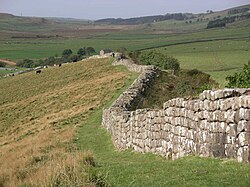英蘇邊界




英蘇邊界是英格蘭和蘇格蘭之間的正式邊界和入境標示,全長154公里,從東岸的陶域河延伸至西岸的索爾威灣。這邊界是蘇格蘭唯一一條陸地邊界,而英格蘭則接鄰威爾斯有更長的邊界。
雖然英格蘭和蘇格蘭在很久以前已經有事實上的邊界,但兩國於1237年才簽訂《約克條約》確立[1];英格蘭於1482年從蘇格蘭奪取卡立爾以北和巴域的小部分地方,稱為「爭議之地」。這是世界上現存古老邊界之一,縱然巴域起初仍未被英格蘭吞併──該地於1885年才因議會緣故而歸屬諾森伯倫。
在王冠聯合前幾個世紀,邊界的兩側都受「邊界流寇」肆虐,而成為不受法律管束之地。
《聯合條約》生效後,英格蘭和蘇格蘭組成大不列顛王國,但英格蘭法律和蘇格蘭法律仍然各自有效,因此這邊界分別出兩個不同司法管轄區[2]。例如,蘇格蘭法律規定的成年年齡是16歲,而英格蘭法律是18歲,所以邊界附近的英格蘭人可以私奔到蘇格蘭,以蘇格蘭法律私底下結婚。
英蘇的海上邊界經《1999年蘇格蘭水域法令》修改,其領海範圍是《1987年民事司法管轄權(離岸活動)法令》設立的北海油田範圍以北0.09公里[3]。
邊界兩側各有歡迎遊客進入英格蘭和蘇格蘭的告示牌。
歷史
[編輯]
邊界原野(border country),歷史上稱為蘇格蘭邊(Scottish Marches)是英蘇邊界的兩側,按現代劃分,包括英格蘭的金巴倫、杜倫、諾森伯倫三郡,和蘇格蘭的鄧弗里斯-格洛威和蘇格蘭邊疆兩議會區。邊界原野是山地,北鄰蘇格蘭的南方高地,南接車韋特山。從諾曼征服英格蘭起,直至蘇格蘭的詹姆士六世統治止,兩國在邊界時常衝突,因此兩國君主各自委任邊疆伯爵和戍邊大臣守衛國土。
氏族
[編輯]16世紀的一道蘇格蘭議會法案談及邊界上的部落頭目,17世紀末的檢察大臣將「家族」(families)和「氏族」(clans)混合使用。雖然蘇格蘭低地的學者認為「氏族」只適用於高地人,而他們自稱為「家族」,但這個分類於19世紀才出現[4]。
歷史上的邊界氏族包括:Armstrong、Beattie、Bannatyne、Bell、Briar、Douglas、Elliot、Graham、Hedley of Redesdale、Henderson、Home或Hume、Irvine、Jardine、Johnstone、Kerr、Little、Moffat、Nesbitt、Ogilvy、Porteous、Scott、Tweedie。
蘇格蘭邊
[編輯]自13世紀,英格蘭愛德華一世冊封首名戍邊大臣起,至17世紀初蘇格蘭的詹姆士六世(即英格蘭的詹姆士一世)設立中土諸郡(Middle Shires)止,英格蘭和蘇格蘭邊界附近的土地稱為「蘇格蘭邊」。
詹姆士成為英蘇兩國共同國王之前,蘇格蘭邊的家族或氏族不時按照自己的利益,而向不同的國家效忠,因此當地形成無法律狀態。一個當地氏族曾盛極一時,雄據英蘇之間的邊界,無視英蘇國家的旨令,稱為「爭議之地」(Debatable Lands)。
中土諸郡
[編輯]英格蘭國王及蘇格蘭國王詹姆士頒令,將邊界易名為「中土諸郡」。1605年,詹姆士成立一個委員會,由英格蘭和蘇格蘭的十人平等組成,以便在當地建立秩序。邊界流寇再無法靠越過邊界來逃避法律責任[5]。簡陋的邊界法律廢除,中土諸郡的居民明白他們需要向其他人一樣遵守法律。
1603年,詹姆士國王任命第一代登巴伯爵佐治·休姆負責在邊界恢復秩序。中土諸郡的城鎮設立法庭,惡名昭著的流寇被補。較棘手和低下階層未經審訊而被處決,稱為「積德堡司法」。大規則問吊屢見不鮮。
1607年,詹姆士自評中土諸郡「已成為兩王國的臍地,滿是文明富裕之人」。他即位十年後,中土諸郡已經受到中央的法律管轄。
1620年初期,邊界地帶一片和平,國王得以減少行動。
然而,聯合委員會仍然運作。直至理查二世治下的1641年時,當地士紳理察·嘉咸爵士向蘇格蘭議會請願,要求「平定邊界的混亂局面」[6]。
流行文化
[編輯]
哈德良長城是幾個世紀以來,不列顛尼亞(大概包含近代的英格蘭及威爾斯)與喀里多尼亞(近代的蘇格蘭)之間的邊界。雖然不列顛尼亞的領土偶爾往北伸延至安東尼長城,但哈德良長城也常用作英蘇邊界的代稱。哈德良長城全部位於英格蘭境內,即近代邊界以南。
爭議領土
[編輯]縱使英蘇邊界於歷史稱得上是穩定,但也有爭議,特別是爭議之地和特韋德河畔巴域。巴域郡屬於蘇格蘭,巴域卻屬於英格蘭,而巴域至19世紀才併入英格蘭的諾森伯倫[7]。支持蘇格蘭獨立的溫蒂·活迪將邊界標誌移到陶域河中間以示抗議[8]。
人口遷移
[編輯]金巴倫和諾森伯倫是蘇格蘭境外最大的蘇格蘭人社群。根據2001年人口普查,金巴倫的3.41%居民(16628人)於蘇格蘭出生,而諾森伯倫的3.72%居民(11435人)於蘇格蘭出生。英格蘭全國人口的1.62%於蘇格蘭出生[9]。
參見
[編輯]參考資料
[編輯]- ^ Scotland Conquered, 1174-1296. The National Archives. [19 May 2012]. (原始內容存檔於2021-02-24).
- ^ Collier, J.G. Conflict of Laws (PDF). Cambridge: Cambridge University Press. 2001: 6 [2014-06-21]. ISBN 0-521-78260-0. (原始內容存檔 (PDF)於2011-09-27).
For the purposes of the English conflict of laws, every country in the world which is not part of England and Wales is a foreign country and its foreign laws. This means that not only totally foreign independent countries such as France or Russia... are foreign countries but also British Colonies such as the Falkland Islands. Moreover, the other parts of the United Kingdom—Scotland and Northern Ireland—are foreign countries for present purposes, as are the other British Islands, the Isle of Man, Jersey and Guernsey.
- ^ Scottish Parliament Official Report 26 April 2000[失效連結]. Retrieved 19 May 2012.
- ^ Agnew, Crispin. Clans, Families and Septs. Electric Scotland. 13 August 2001 [19 May 2012]. (原始內容存檔於2021-02-11).
- ^ Act anent fugitive persones of the borders to the in countrey (1609): Forsamekle as the kingis majestie is resolved to purge the mydele schyres of this isle, heirtofoir callit the bordouris of Scotland and England, of that barbarous crueltie, wickednes and incivilitie whilk be inveterat custome almaist wes become naturall to mony of the inhabitantis thairof...(現代英語: Forasmuch as the king's majesty is resolved to purge the middle shires of this isle, heretofore called the borders of Scotland and England, of that barbarous cruelty, wickedness and incivility which by inveterate custom almost was become natural to many of the inhabitants thereof...)
- ^ 理察·嘉咸爵士的請願內容: I am desired by Sir Richard Graham to move your majesty and this house of parliament that some present course may be taken for regulating the disorders that are now in the middle shires, this being the best time whilst the English commissioners are here that order may be given to the commissioners of both kingdoms to call the border landlords now in town to inform themselves what course has been formerly held for the suppressing of disorder and apprehending of felons and fugitives.
- ^ Kerr, Rachel. A tale of one town. BBC News. 8 October 2004 [13 April 2007]. (原始內容存檔於2021-03-09).
- ^ Swapping sides: the English town that wants to be Scottish. The Independent. 13 February 2008 [31 December 2009]. (原始內容存檔於6 July 2008).
It was Berwick which became the focal point for the direct action of one of the first modern Scottish nationalists, Wendy Wood in the 1950s. Controversially...she was regularly arrested for moving the border signs over the Tweed.
- ^ Neighbourhood Statistics Home Page. Office for National Statistics. [19 May 2012]. (原始內容存檔於2008-12-31).
延伸閱讀
[編輯]- Aird, W.M. (1997) "Northern England or southern Scotland? The Anglo-Scottish border in the eleventh and twelfth centuries and the problem of perspective" In: Appleby, J.C. and Dalton, P. (Eds) Government, religion and society in Northern England 1000-1700, Stroud: Sutton, ISBN 0-7509-1057-7, p. 27–39
